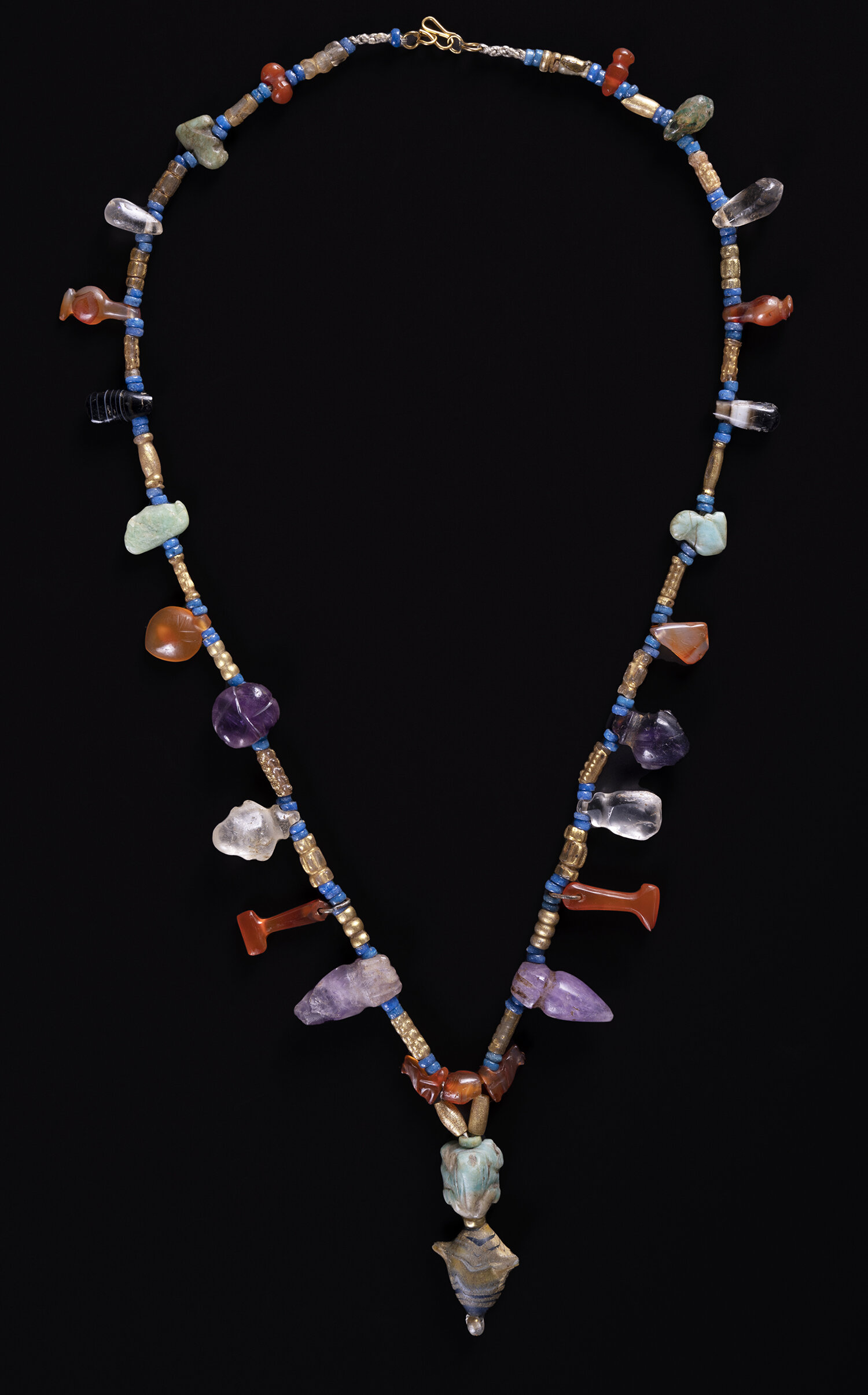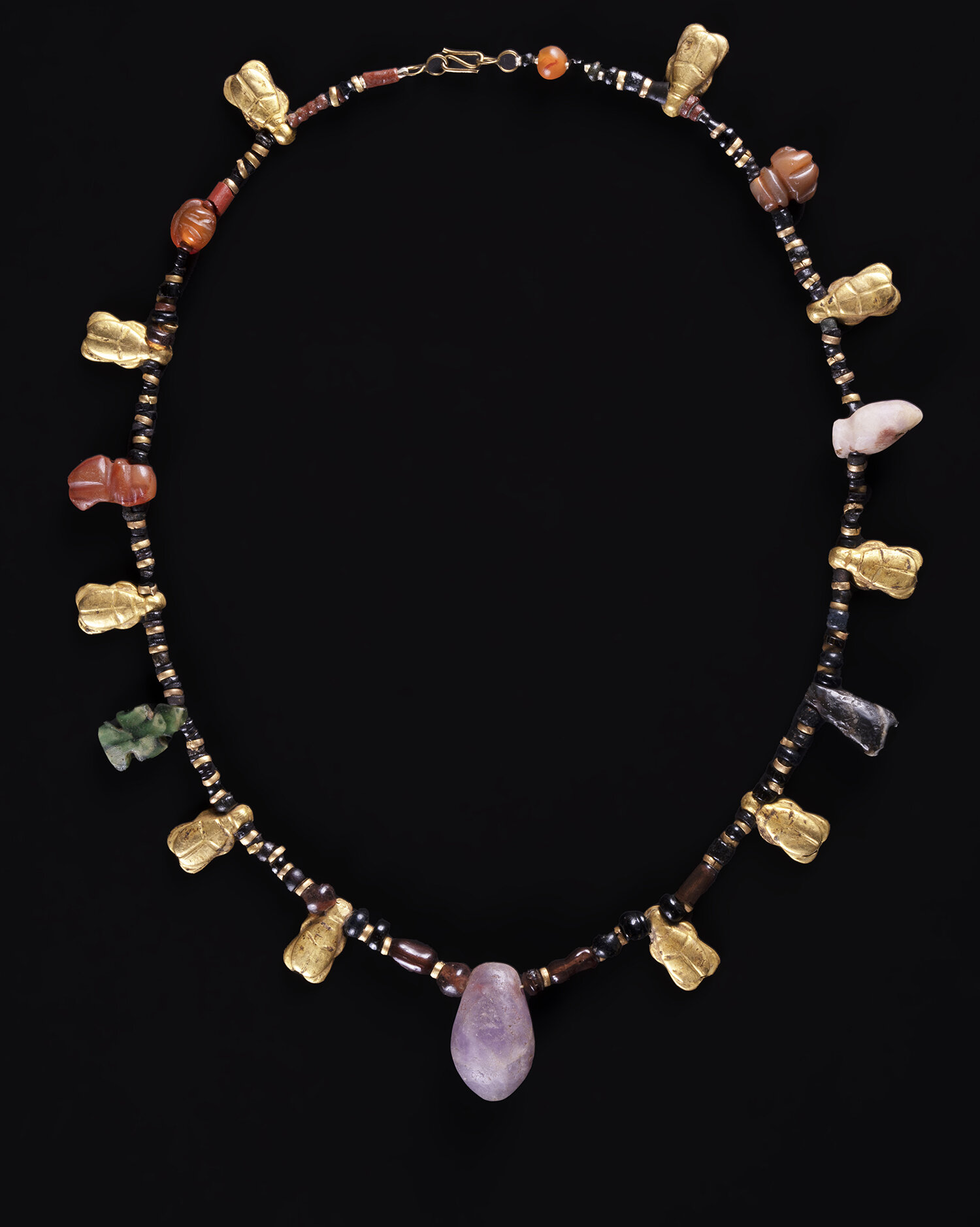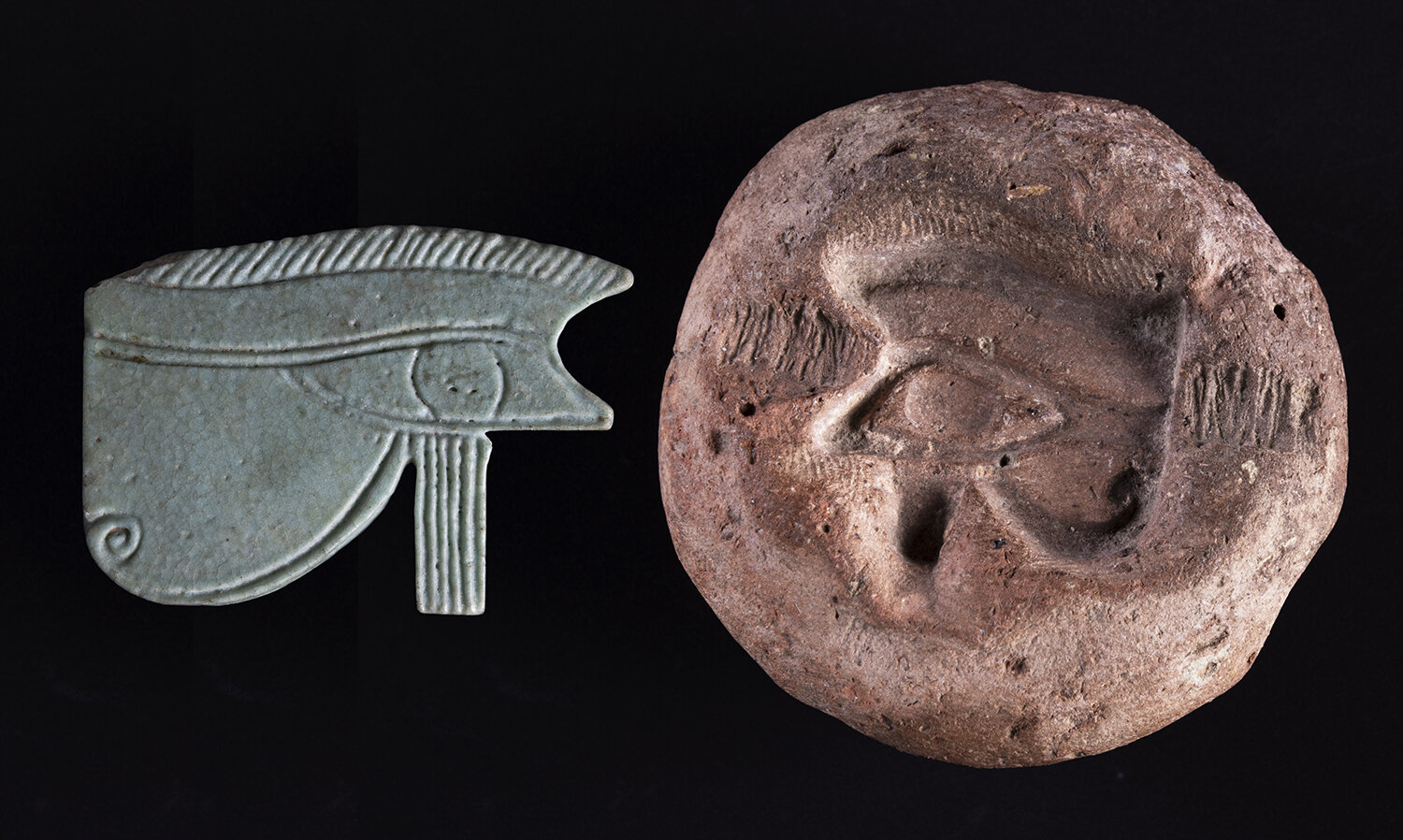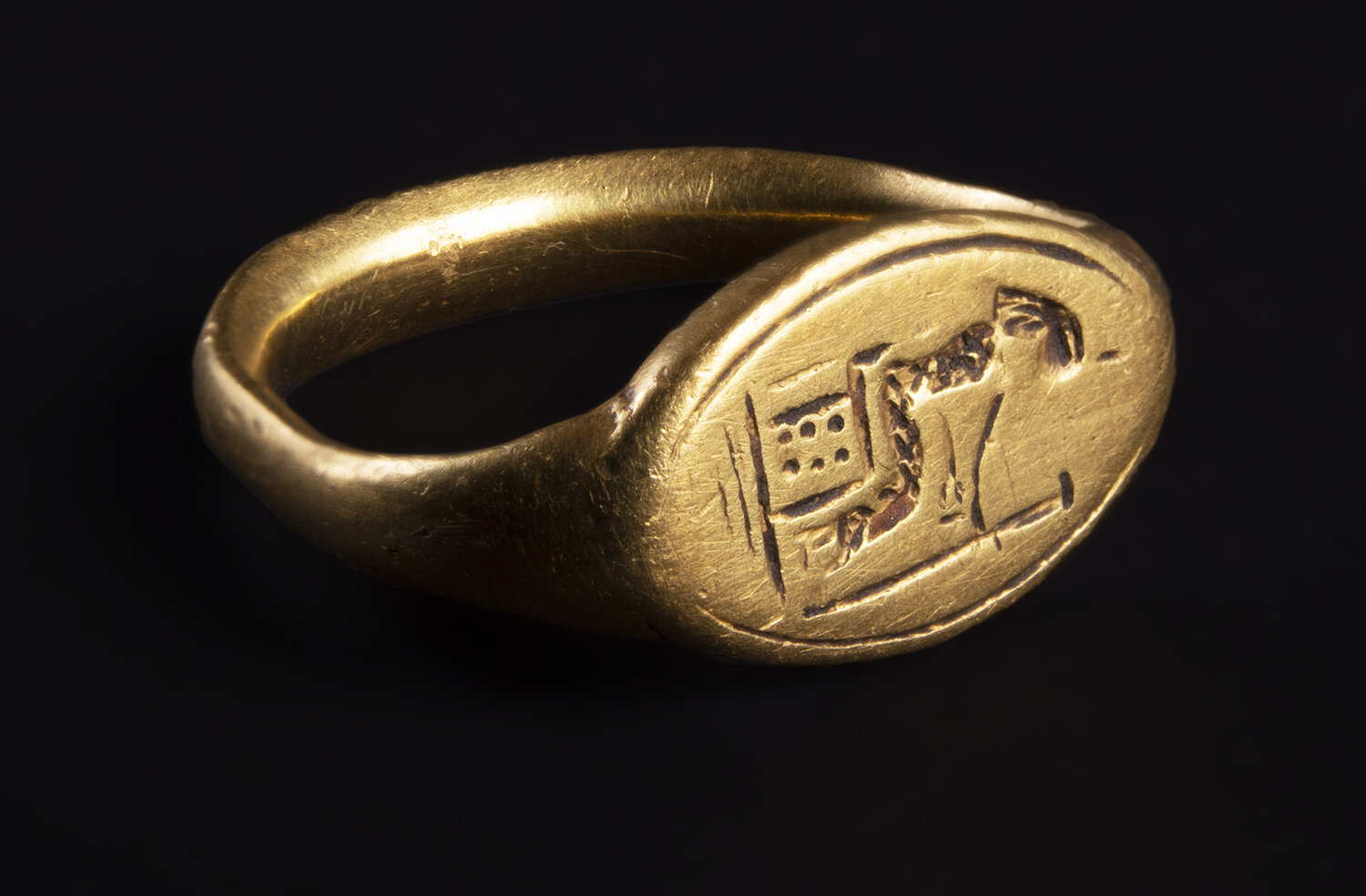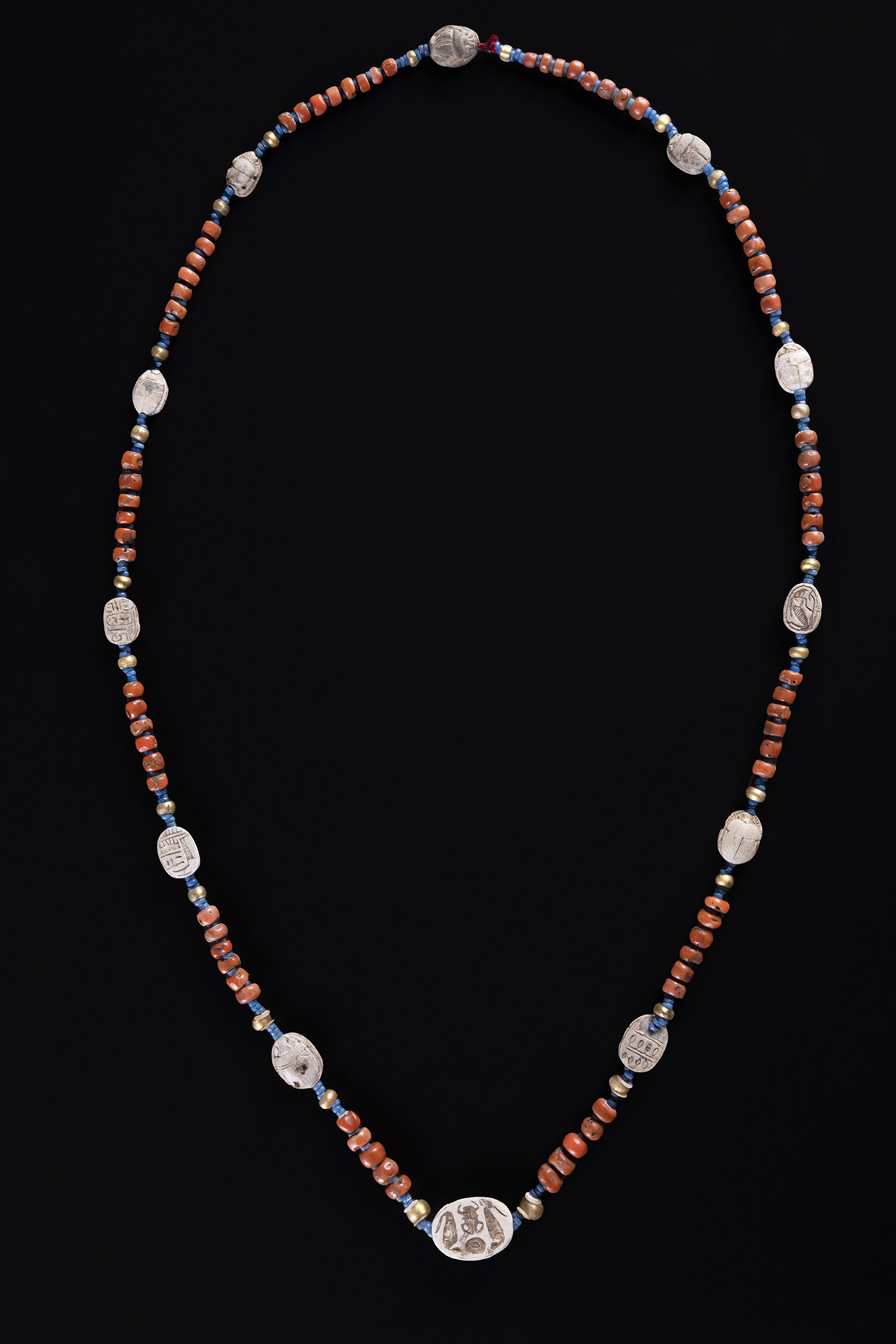Glencairn Museum News | Number 2, 2020
This brilliant blue scarab is carved from lapis lazuli (05.JW.180). Scarabs first become incorporated into finger rings in the Middle Kingdom (1980-1630 BCE).
Jewelry appears in the archaeological record in Egypt as early as 4500 BCE, in the form of beads made of shell and glazed stones. Beginning in the prehistoric periods, Egyptian burials included jewelry, indicating an interest in personal adornment. Over the more than 3000 years of pharaonic history, Egyptian artisans produced a dazzling variety of jewelry meant to be worn by the living and the dead, men and women, human and divine. The jewelry in Glencairn’s Egyptian collection represents much of the long history of ancient Egyptian ornamentation. Individual elements of jewelry in the collection date from the First Intermediate Period (2130-1980 BCE) through the Greco-Roman Period (332 BCE-323 CE) and beyond.
Figure 1: Some of the earliest jewelry in the collection can be found on this necklace, which features amulets carved from a variety of semi-precious stones including carnelian, amethyst, quartz, and green feldspar. The forms include a frog, falcons, human legs, hearts, poppy flowers, and female-headed sphinxes (15.JW.184).
Raymond Pitcairn acquired his collection of ancient jewelry from a Lebanese antiquities dealer by the name of Azeez Khayat and his son, Victor, during the 1920s and 1930s (Figure 2). Khayat was an amateur archaeologist who carried out his own excavations in Lebanon, Egypt, Syria, and Greece. The Khayats had offices in New York City, Haifa, and Cairo, where they sold the finds from their excavations. Today, antiquities laws prevent this practice, but in the early decades of the 20th century many well-known private collectors, as well as major museums, purchased antiquities from the Khayats.
Figure 2: Victor A. Khayat looking at antiquities in 1923. National Photo Company Collection (Library of Congress).
Figure 3: The eleven gold rings in this necklace were in all likelihood originally earrings. Azeez Khayat, the antiquities dealer who sold the necklace to Raymond Pitcairn, often created necklaces for his clients by incorporating a variety of elements from different periods of Egyptian history (15.JW.349).
Most of the necklaces in the Pitcairn collection are made up of elements that originally derived from a variety of ancient sources. As was typical at this time, antiquities dealers would restring ancient beads and amulets into designs that would be attractive to the modern collector. Raymond Pitcairn was aware of this practice, and he sometimes asked Khayat to restring individual necklaces to make them more appealing before he purchased them. Mildred, his wife, was also involved in the selection of some of the early jewelry purchases acquired from the Khayats. When Raymond purchased the jewelry now in Glencairn Museum’s collection, he intended for it to be worn (Figure 4). He purchased the jewelry as gifts for Mildred and other female family members—their daughters and granddaughters were each allowed to select a necklace for themselves.
Figure 4: Raymond and Mildred Pitcairn at a political event in 1960. Mildred wears an ancient necklace.
Raymond Pitcairn had an artist’s eye. His fascination with design, apparent in his intense interest in architecture and interiors, extended also to the clothing worn by his wife and daughters. He designed dresses and gowns for Mildred to wear on special occasions, and it was not uncommon for elements of ancient jewelry to be incorporated into the dresses’ embellishments.
One dress in particular stands out (Figure 5). Most likely designed by Raymond, this dress (currently on exhibit in Glencairn’s Upper Hall) is constructed of a subtle gold silk and trimmed in fur at the wrists and hem. The seamstress embroidered the shoulders and bodice with ancient beads, and a striking gold medallion dating to the Byzantine period takes the central position on the center of the chest (Figure 6). There do not appear to be any photographs of Mildred wearing the dress, but other family members are pictured wearing it on special occasions in later years.
Figure 5: One of the Pitcairns’ great-granddaughters models the “King Tut” dress in connection with a private event in 1987 at the Philadelphia Museum of Art.
Figure 6: A striking gold medallion dating to the Byzantine period (perhaps 4th-7th century CE) takes the central position on the chest. The medallion, made in the eastern Mediterranean (perhaps Syria or Lebanon), may have been repurposed from a larger piece of jewelry such as a bracelet or armlet. The scene represents a procession of Dionysos, the ancient Greek god of wine, through North Africa. Silenus, a companion of Dionysos, is depicted reclining backwards on a camel in a drunken state.
This dress was known fondly to family members as the “King Tut” dress (although none of the jewelry elements incorporated into its design came from the tomb of Tutankhamun). It is interesting to note that during the 1920s and 1930s, when Pitcairn purchased the jewelry in this collection, the country was swept up in a wave of “Egyptomania.” People were fascinated with the discovery of the tomb of the boy king Tutankhamun by Howard Carter in 1922; as a result, Egyptian motifs became very popular in architecture, home décor, clothing, and jewelry design. It is perhaps this moment of Egyptian revival that caused the dress to become known as the “King Tut” dress.
Ancient Egyptian jewelers were masters at their craft. Working in an array of both man-made and natural materials, they used a variety of techniques to create beautiful jewelry, from simple strings of beads to elaborately detailed pendants. The jewelry in Glencairn’s collection represents a diverse assortment of materials, including semi-precious stones and metals such as gold, silver, and bronze.
Figure 7: Ten small, gold scarabs decorate this necklace, which is interspersed with amulets made from other semi-precious stones (15.JW.399).
While much of the raw material could be found within Egypt’s borders, some of the resources for jewelry-making had to be imported. Lapis lazuli, a semi-precious stone with a dark blue color, was a very expensive commodity that had to be obtained from as far away as Afghanistan. Most of the gold used in Egyptian jewelry was sourced from mines in Nubia, Egypt’s southern neighbor. Other materials were less costly. Carnelian, for example, which varies from a deep red to a pale orange, could be sourced locally in the Egyptian desert. Color had symbolic meaning to the ancient Egyptians. Some colors were associated with the sun and the solar aspects of Egyptian religion. Other colors were connected with the idea of rebirth or regeneration. Therefore, the various hues of the adornments added magical protection for the wearer.
One of the most common materials used in the production of Egyptian jewelry is faience, a man-made, self-glazing composition comprised of crushed quartz, alkaline salts, lime, and colorants. Egyptian jewelers used faience to make beads, amulets, inlays, vessels, and figurines. Most of the faience objects in the Glencairn collection were made in ceramic molds, hinting at mass production methods (Figure 8). It could be produced in a variety of colors, but the most popular color was a turquoise blue.
Figure 8: Most of the faience amulets in the exhibition were mass-produced in ceramic molds like these. Faience paste was pressed into the mold to make a positive form, and then quickly removed. The amulet was then placed in a kiln. This mold in Glencairn’s collection was used for making the very popular wedjat eye amulet, which was worn to promote health and well-being.
Egyptian adornment decorated parts of the body from head to foot. It was worn during life and placed in the burial with the deceased. Diadems, hairpins, and hair rings adorned the head. Earrings in both stud and hoop styles became popular in the New Kingdom and remained in use through the Roman period. Collars, necklaces, and pendants adorned the necks of both men and women. Bracelets, armlets, and anklets could be worn on the arms and legs. Finger rings appear in a variety of styles. Women could wear strings of beads low-slung on their hips in a type of jewelry called a girdle.
Throughout their lives, the ancient Egyptians revered gods and goddesses, and sought protection and intercession from them through prayers, rituals, and offerings. After death, they hoped to be able to join with them in the afterlife. The Egyptian pantheon was vast, with dozens of gods and goddesses. Certain deities could represent natural phenomena like the sun, the moon, or the inundation of the Nile. Other deities were closely connected to kingship and the royal sphere, while others protected the house and home. Many deities were associated with death, burial, and the afterlife.
Figure 9: A sunk relief (intaglio) image of a seated Egyptian goddess decorates the bezel of this signet ring (05.JW.330). She sits on a low-backed throne and holds a staff in her outstretched hand. Her dress is designed with a pattern of beaded netting. The goddess appears to have a uraeus (rearing cobra) at her brow. It may be an image of Isis.
Amulets of gods and goddesses were popular talismans to ensure divine protection and to indicate devotion. In addition to divine imagery, the Egyptians incorporated into their jewelry signs and symbols derived from the natural world and from hieroglyphic writing. Usually taking the form of amulets, these small images represented words with positive and powerful meanings.
Figure 10: Djed pillar amulets were often found placed on the lower torso of mummies. This form came to be associated with the backbone of the god Osiris. A spell from The Book of the Dead says, “Raise yourself up, Osiris! You have your backbone once more, O Weary-hearted One; you have your vertebrae.” Through recitation of this spell, the deceased who possessed a djed pillar amulet would be identified as being one with Osiris (15.JW.574).
Figure 11: Necklace with pendant of Duamutef, one of the sons of Horus (15.JW.559). During the mummification process, the internal organs were removed and mummified separately. The organs were then placed in jars with lids decorated with the heads of four deities: Hapy, Qebehsenuef, Imsety, and Duamutef. These deities protected the internal organs. Duamutef had the head of a jackal and protected the stomach.
The deceased was also equipped with amulets for protection, and there are lists of prescribed amulets indicating where on the mummy they should be placed. Amulets of the four sons of Horus (the same deities whose images topped canopic jars containing the major organs) were popular funerary talismans, and were often incorporated into elaborate “mummy bead” net shrouds which covered the mummy. Funerary spells, like those found in The Book of the Dead, also mention the use of amulets.
The Egyptians were keen observers of nature and witnessed dung beetles (Scarabeus sacer) pushing balls of dung across the sand. This led to the belief that it was a dung beetle that rolled the sun-disk across the sky. They also observed young beetles hatching from these balls, and interpreted the scarab as a symbol of rebirth and regeneration. There are a number of different ways that the Egyptians incorporated scarabs into their adornment. Certain types of scarabs were used by the living, and other types were more funerary in nature.
The Egyptians used amulets shaped like scarab beetles as seals, piercing the scarab longitudinally to allow it to be strung or incorporated into a ring (Figure 12). The upper side of a scarab seal resembles a beetle, while the flat underside bears incised decoration. Sometimes these designs are purely decorative, featuring spiral designs or protective images. At other times the bottom of the scarab contains the name and titles of its owner, and would have functioned like a signet ring. In this way the scarab served two purposes: a magical association with rebirth and, when used to seal things, an administrative function marking ownership.
Figure 12: Necklace with scarabs (15.JW.275). Twelve scarabs of various dates are strung on this necklace. One of the scarabs has the cartouche of Tuthmosis III, one of Egypt’s great warrior pharaohs of the New Kingdom.
Funerary scarabs come in a few different forms. One type is a small amulet about the same size as those used as a seal. Larger scarabs with outstretched wings are another funerary form; amulets of this type were attached to the wrappings of mummies. Finally, the best-known of the funerary scarabs is the heart scarab. This is a large-scale scarab whose lower surface is flat and contains a spell from a funerary text, The Book of the Dead. This spell offers words of magical protection for the heart of the deceased when it was weighed on a scale during the final judgment.
Jewelry was an important part of daily life for the ancient Egyptians. Adorning the deceased and equipping them with jewelry for the afterlife was equally important. The jewelry in this exhibition is attractive and may have indicated the rank or wealth of its owners. However, most of these pieces also had protective and religious functions. The beautiful jewelry in this exhibition provides excellent examples of the Egyptians’ interest in sacred adornment for this life and the beyond.
Jennifer Houser Wegner, PhD
Associate Curator, Egyptian Section
Penn Museum, University of Pennsylvania
A complete archive of past issues of Glencairn Museum News is available online here.


